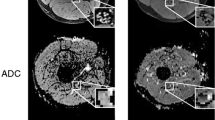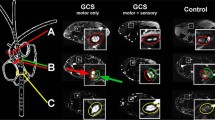Abstract
Lewis-Sumner syndrome (LSS) is an atypical variant of chronic inflammatory demyelinating polyneuropathy characterized by an asymmetric sensory-motor neuropathy with multifocal distribution. The diagnosis is typically clinical and electrophysiological but in some cases might be challenging causing a significant therapeutic delay. Diffusion tensor imaging (DTI) has been progressively used for the in vivo assessment of peripheral nerves integrity. In this study, we aimed to elucidate if DTI was able to detect the specific nerve damage in a patient with suspected LSS, and determine if DTI presented a specific pattern that could be useful in its differential diagnosis. A 38-year-old male with a right foot drop was studied. Physical examination, electrodiagnostic, and MRI studies were performed. MRI of the lower limb was acquired in a 3-T scanner and included T1-wi, T2-TSE-SPIR, and PD-TSE-SPAIR images in axial and coronal planes. Axial DTI was acquired using a single-shot EPI sequence with diffusion encoding in 32 directions. The electrodiagnostic tests suggested a demyelinating sensorimotor neuropathy with conduction blocks. Conventional MRI was normal. DTI showed pathological results in Tibial and Peroneal nerves consisting of thinning and discontinuities along both nerves but more significant in the Peroneal. Compared with MRI, DTI offered a significant improvement to detect the specific nerve damage and its characteristics. The observed nerve damage in DTI suggested polyneuropathy and was compatible with the electrophysiological findings, endorsing the LSS diagnosis. This is the first report in the literature presenting the DTI findings in LSS.




Similar content being viewed by others
References
Kuwabara S, Misawa S. Chronic inflammatory demyelinating polyneuropathy. Adv Exp Med Biol. 2019;1190:333–43.
Shahram A, Verschueren A, Jérome F, Salort-Campana E, Jouve E, Pouget J. Response to treatment in patients with Lewis-Sumner syndrome. Muscle Nerve. 2011;44:179–84.
Lehmann HC, Burke D, Kuwabara S. Chronic inflammatory demyelinating polyneuropathy: update on diagnosis, immunopathogenesis and treatment. J Neurol Neurosurg Psychiatry. 2019;90:981–7.
Chhabra A, Madhuranthakam AJ, Andreisek G. Magnetic resonance neurography: current perspectives and literature review. Eur Radiol. 2018;28(2):698–707.
Bernabeu A, Láopez-Celada S, Alfaro A, Mas JJ, Sánchez-González J. Is diffusion tensor imaging useful in the assessment of the sciatic nerve and its pathologies? Our clinical experience. Br J Radiol. 2016;89(1066):20150728.
Author information
Authors and Affiliations
Corresponding author
Ethics declarations
Ethics approval and consent to participate
All procedures performed were in accordance with the ethical standards of the institutional and/or national research committee and with the 1964 Helsinki Declaration and its later amendments or comparable ethical standards.
Consent for publication
Informed consent was obtained from the subject described in this report.
Conflict of interest
The authors declare that they have no conflict of interest.
Additional information
Publisher’s note
Springer Nature remains neutral with regard to jurisdictional claims in published maps and institutional affiliations.
Rights and permissions
Springer Nature or its licensor (e.g. a society or other partner) holds exclusive rights to this article under a publishing agreement with the author(s) or other rightsholder(s); author self-archiving of the accepted manuscript version of this article is solely governed by the terms of such publishing agreement and applicable law.
About this article
Cite this article
Alfaro, A., Picorelli, S., Jiménez, J. et al. Lewis-Sumner syndrome: contribution of diffusion tensor imaging in its differential diagnosis. Skeletal Radiol 52, 1237–1242 (2023). https://doi.org/10.1007/s00256-022-04236-w
Received:
Revised:
Accepted:
Published:
Issue Date:
DOI: https://doi.org/10.1007/s00256-022-04236-w




